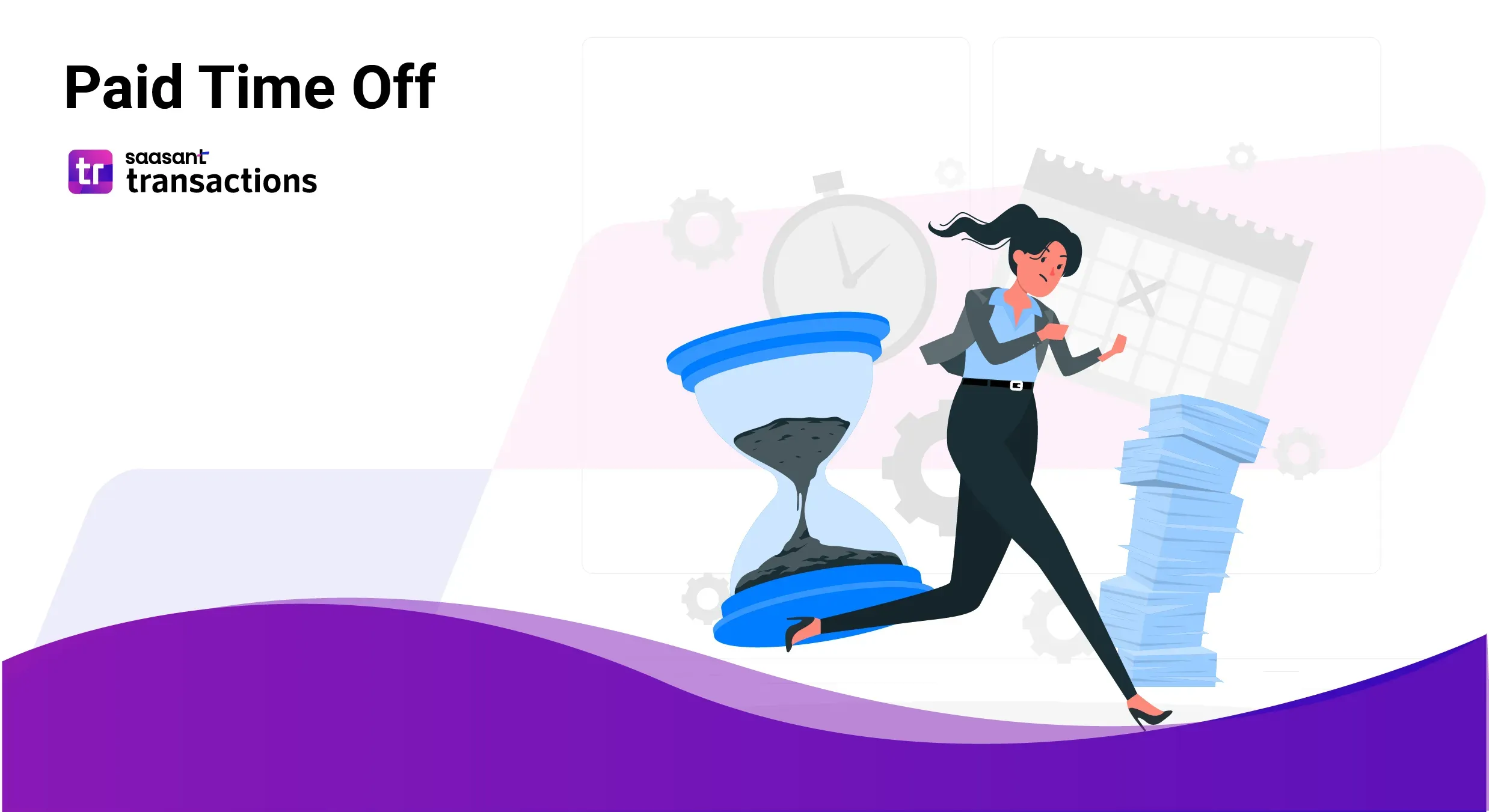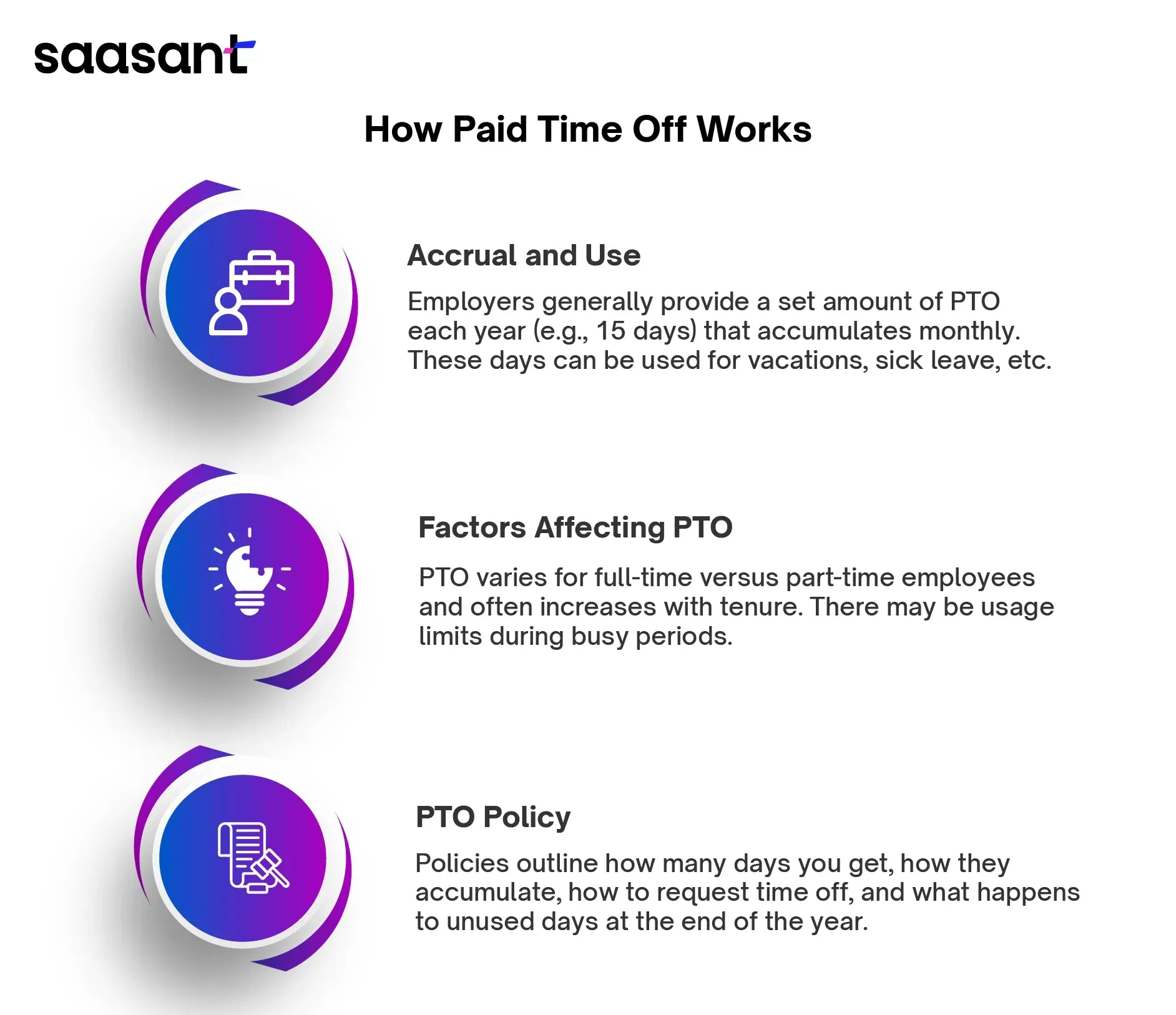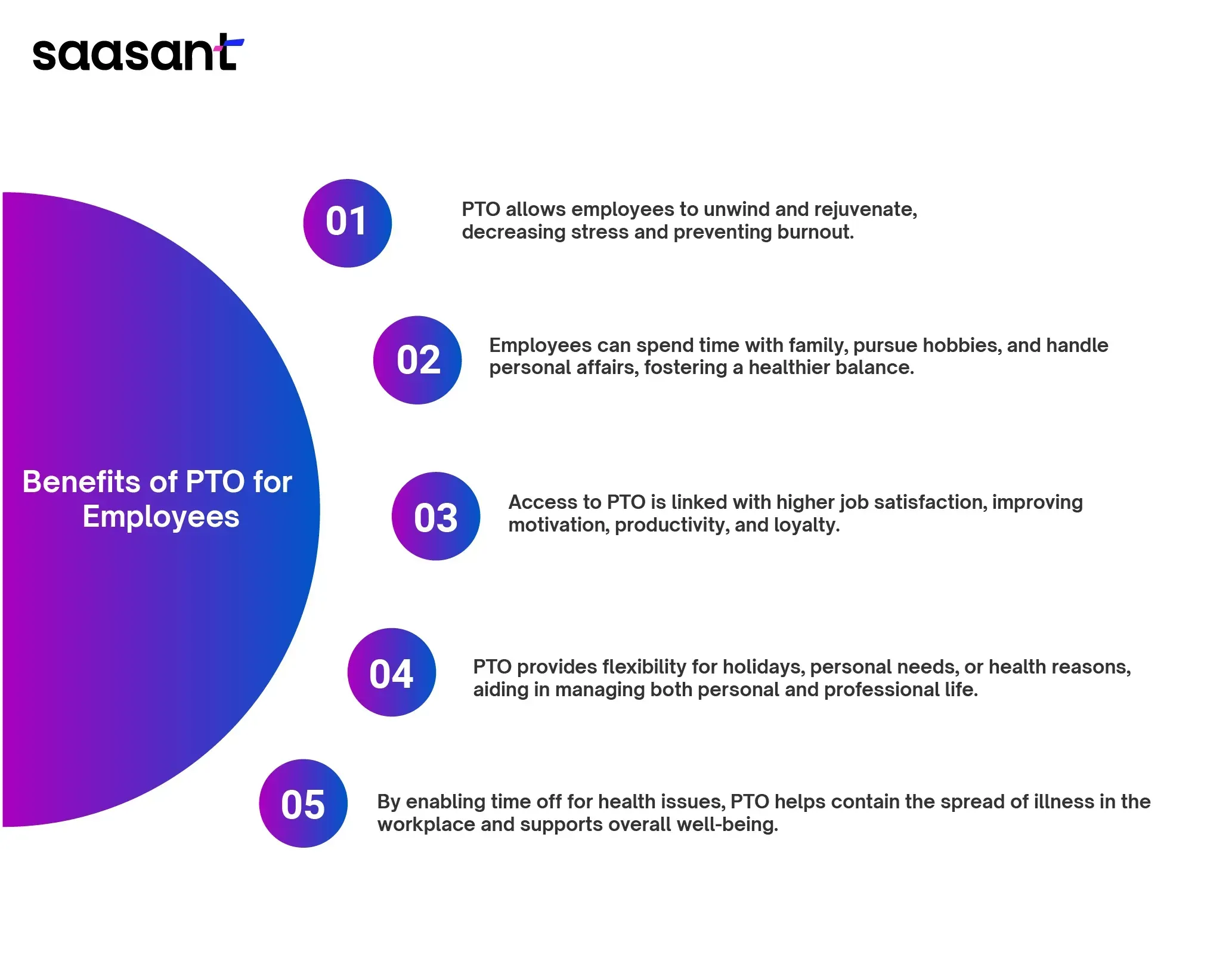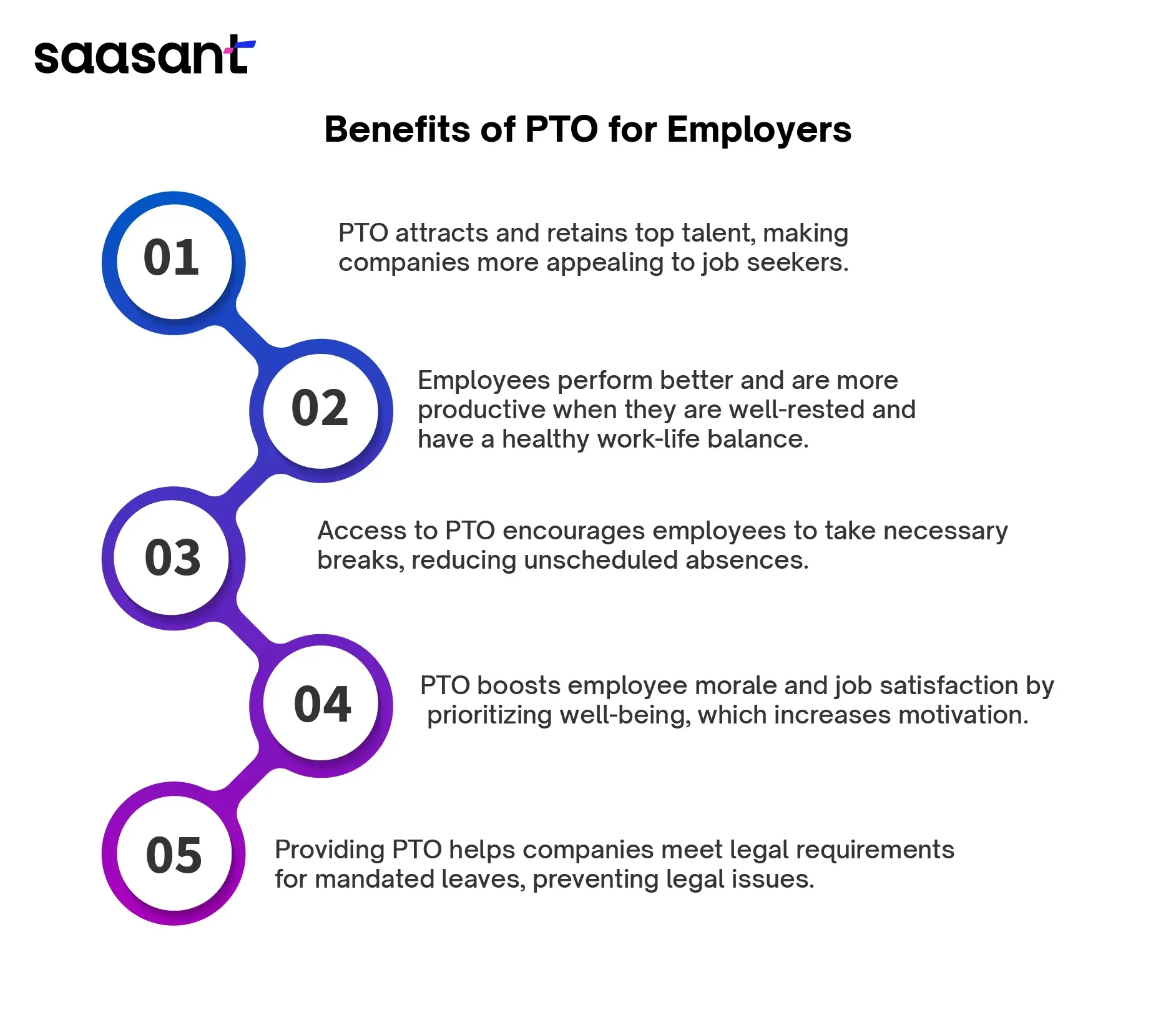PTO Meaning - Definition of Paid Time Off

Balancing work and personal life is crucial for employees, but it can be tough to take time off and still get paid. That's where paid time off (PTO) plays a crucial role. In this blog, we'll explore PTO and its types, how it works, the benefits of PTO for employees and employers, and tips for using your PTO.
Contents
What is PTO (Paid Time Off)?
Types of PTO
How Paid Time Off Works
Benefits of PTO for Employees
Disadvantages of Paid Time Off
Tips for Using Your PTO
Conclusion
FAQs
What is PTO (Paid Time Off)?
Paid time off, or PTO or personal time off, is a benefit employers provide where employees are paid during their absence from work. Employees can use PTO for various reasons, including sick days, vacations, and personal appointments. Many companies opt for a consolidated PTO approach rather than having separate allocations for vacation, sick time, or individual days.
There are various policies on how PTO works, the most common being the accrual of hours in a bank. The longer employees work at the company, the more hours they accumulate in this bank, which they can use as needed. Additionally, many employers offer a rollover policy, allowing employees to carry over unused PTO hours to the following year.
Types of PTO
There are various types of paid time off (PTO):
Vacation Days: Employees use these days for leisure activities such as travel or relaxation. They are generally planned and provide a break from work duties.
Sick Leave: This allows employees to take time off when they or an immediate family member are ill or injured.
Personal Days: These are for attending to personal affairs, completing errands, or managing unexpected events.
Holidays: Employees can take these days off during public celebrations like Christmas, New Year’s, or Independence Day.
Bereavement Leave: This type of leave is granted so employees can mourn the loss of a close family member.
Jury Duty: Employees use this time off to serve on a jury as the law requires.
How Paid Time Off Works

Accrual and Usage of PTO
Employers often allocate a specific number of PTO days each year based on the number of days or hours an employee works. For instance, an employer might provide 15 PTO days annually, accumulating at a rate of 1.25 days per month. Employees are free to use these PTO days for various needs, such as vacation, sick leave, personal days, holidays, bereavement leave, or jury duty.
Factors Influencing PTO Accrual and Usage
The accrual and usage of PTO can differ based on employment status, with distinct policies for full-time versus part-time employees, or vary by tenure, where longer-serving employees receive more PTO days. Additionally, employers might impose blackout periods or usage restrictions during peak business times or significant projects.
PTO Policy
A company's PTO policy typically details the structure of the PTO program, including total PTO days, accrual rates, procedures for requesting PTO, tracking PTO usage, and handling of unused PTO at year-end.
PTO policies can differ widely between companies. For example, some companies offer unlimited PTO, allowing employees to take as much time off as needed, provided their work meets deadlines and quality standards. Challenges with unlimited PTO can include potential misuse and difficulties in monitoring how much time employees take off.
Remember that the typical leave policy for employees stipulates that PTO is use-it-or-lose-it, meaning unused days do not roll over to the following year. Also, there might be a cap on the maximum number of PTO days one can accumulate, with any excess potentially being lost.
Benefits of PTO for Employees
Here are several advantages of paid time off (PTO) for employees:

PTO provides a vital break from work, allowing employees to unwind and rejuvenate. This downtime can help decrease stress, enhance mental well-being, and prevent burnout.
PTO enables employees to spend more time with loved ones, engage in hobbies, and attend to personal affairs, fostering a healthier work-life balance.
Access to PTO often correlates with higher job satisfaction, boosting motivation, productivity, and company loyalty.
PTO allows employees to take time off as needed—for a holiday, personal needs, or health reasons—helping them manage their personal and professional lives more effectively.
By allowing employees time off for health issues, PTO helps prevent the spread of illness in the workplace and supports overall health and well-being.
Benefits of PTO for Employers
Below are some of the benefits of Paid Time Off for employers:

PTO is a compelling benefit that can help employers draw and keep top talent. Companies that offer PTO are generally more appealing to job seekers. Employees often remain with organizations that provide this benefit for longer.
Employees tend to be more productive and perform better when they are well-rested and maintain a healthy work-life balance. Employers can help employees rejuvenate by offering PTO, allowing them to return to work refreshed and energized. Integrating a strategic work schedule can further amplify this effect.
Providing PTO can reduce absenteeism, as employees with access to paid time off are likelier to take necessary breaks and less likely to take unscheduled time off.
PTO can significantly improve employee morale and job satisfaction. When employees see that their well-being is valued and they are given the time off they need, their engagement and motivation typically increase.
Many jurisdictions mandate certain types of leave, such as sick or family leave. Offering PTO can help employers comply with these legal requirements, avoiding potential legal issues.
Disadvantages of Paid Time Off
While paid time off (PTO) significantly benefits employees, it has some disadvantages for employers. Here are a few disadvantages of PTO:
Cost:
Implementing PTO incurs expenses for employers since they must compensate employees during their absence. This can cause financial challenges for smaller businesses with tight budgets.
Productivity:
Employees taking time off can disrupt productivity, mainly if their responsibilities fall to others. This scenario is often more acute in small businesses with fewer staff members.
Tracking and Management:
PTO can be challenging even for larger companies. Employers require HR expertise and robust systems to monitor PTO use and ensure compliance with policy limits.
Tips for Using Your PTO
Here are some tips to help you get the most out of your PTO:
Plan Ahead:
At the start of the year, plan how many days you'll need off. Planning early helps you manage your work effectively, ensuring high quality before and after your break.
Inform Your Manager Early:
Request your time off well in advance to secure approval and ease any worries about your vacation. Refer to your employee handbook to check if there’s a required notice period, like two weeks.
Use Paid Holidays:
For longer vacations, try using the company holidays. This strategy gives you extra time off without draining your accumulated PTO.
Conclusion
PTO is crucial to any company's HR strategy. It offers employees necessary breaks and helps attract and retain employees. PTO policies must be carefully managed to ensure they are equitable and beneficial for both employees and employers.
FAQs
What does PTO stand for?
PTO stands for paid time off (PTO). This policy generally combines personal days with vacation time. While all vacation time is considered PTO, not all PTO constitutes vacation. PTO includes parental leave, jury duty, sick leave, holiday pay, bereavement leave, and disability leave.
How is PTO calculated?
Employers can calculate PTO by dividing the total annual PTO hours by the total yearly work hours. For instance, if an hourly employee accumulates 80 hours of PTO annually and works 40 hours a week, totaling 2,080 hours a year, you would calculate the PTO by dividing 80 by 2,080.
How many hours of PTO do I earn?
If you accrue 120 hours of PTO per year and are paid weekly, you would divide 120 by 52, resulting in approximately 2.3 hours of PTO per pay period. For those paid biweekly, it's about 4.6 hours; for semimonthly payments, it's 5 hours; and for monthly payments, it's 10 hours. To determine your PTO, multiply the hours of PTO per pay period by the amount of time you have worked. Ultimately, PTO earnings are calculated based on your work time.
Does PTO expire?
Employers can restrict the carryover of PTO, but any limitations must be uniformly enforced across all employees. While employers may choose to compensate employees for unused PTO upon their departure, they are not obligated to do so.
How many days is good for PTO?
Individuals with less than one year of experience take about 13 days of paid leave annually. In contrast, those with over 20 years of experience usually take up to 20 days of paid leave each year.